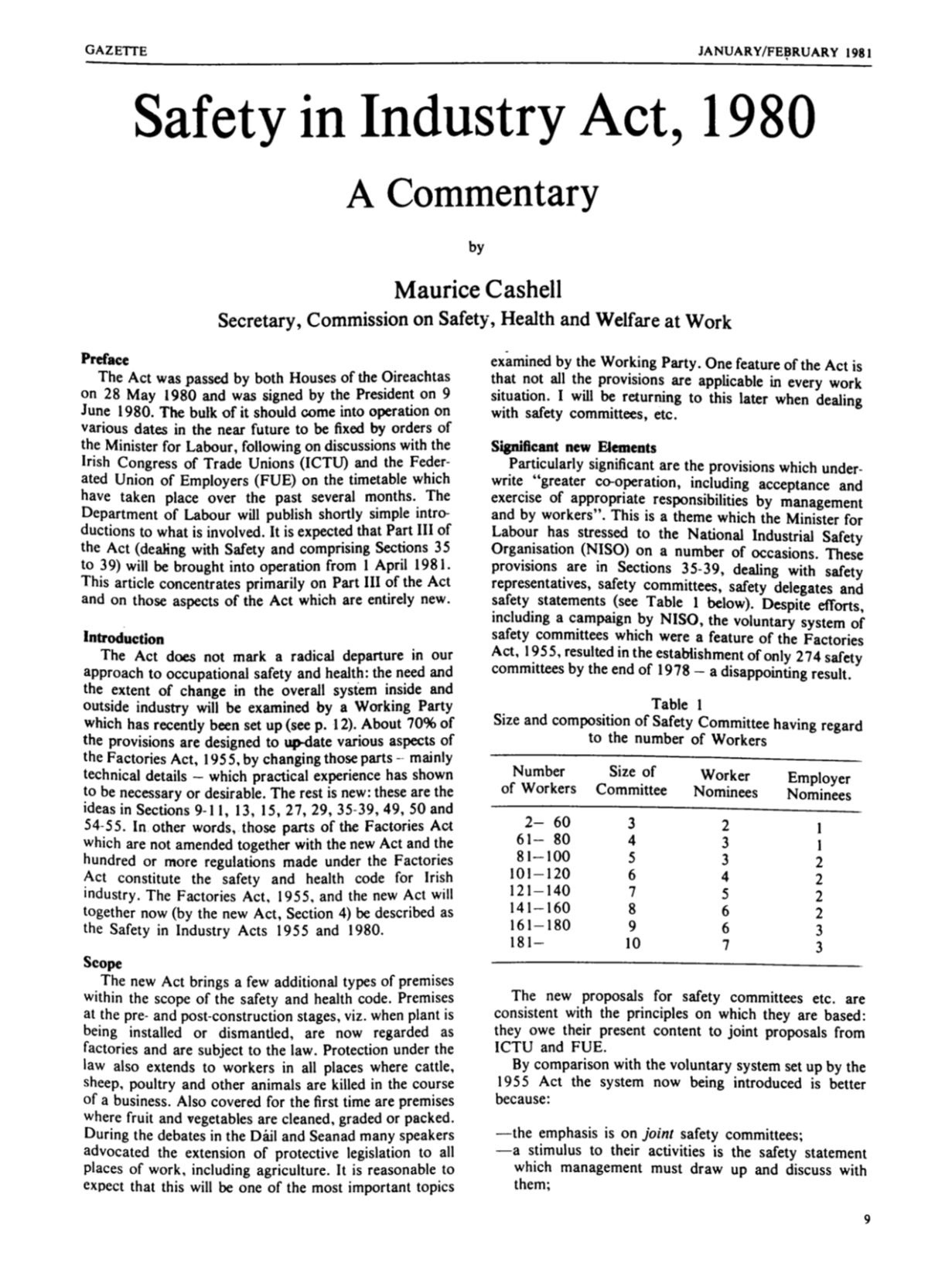

GAZETTE
JANUARY/FEBRUARY 1981
Safety in Industry Act, 1980
A Commentary
by
Maurice Cashell
Secretary, Commission on Safety, Health and Welfare at Work
Preface
The Act was passed by both Houses of the Oireachtas
on 28 May 1980 and was signed by the President on 9
June 1980. The bulk of it should come into operation on
various dates in the near future to be fixed by orders of
the Minister for Labour, following on discussions with the
Irish Congress of Trade Unions (ICTU) and the Feder-
ated Union of Employers (FUE) on the timetable which
have taken place over the past several months. The
Department of Labour will publish shortly simple intro-
ductions to what is involved. It is expected that Part III of
the Act (dealing with Safety and comprising Sections 35
to 39) will be brought into operation from 1 April 1981.
This article concentrates primarily on Part III of the Act
and on those aspects of the Act which are entirely new.
Introduction
The Act does not mark a radical departure in our
approach to occupational safety and health: the need and
the extent of change in the overall system inside and
outside industry will be examined by a Working Party
which has recently been set up (see p. 12). About 70% of
the provisions are designed to up-date various aspects of
the Factories Act, 195 5, by changing those parts - mainly
technical details — which practical experience has shown
to be necessary or desirable. The rest is new: these are the
ideas in Sections 9-1 1, 13, 15, 27, 29, 35-39, 49, 50 and
54-55. In other words, those parts of the Factories Act
which are not amended together with the new Act and the
hundred or more regulations made under the Factories
Act constitute the safety and health code for Irish
industry. The Factories Act, 1955, and the new Act will
together now (by the new Act, Section 4) be described as
the Safety in Industry Acts 1955 and 1980.
Scope
The new Act brings a few additional types of premises
within the scope of the safety and health code. Premises
at the pre- and post-construction stages, viz. when plant is
being installed or dismantled, are now regarded as
factories and are subject to the law. Protection under the
law also extends to workers in all places where cattle,
sheep, poultry and other animals are killed in the course
of a business. Also covered for the first time are premises
where fruit and vegetables are cleaned, graded or packed.
During the debates in the Dáil and Seanad many speakers
advocated the extension of protective legislation to all
places of work, including agriculture. It is reasonable to
expect that this will be one of the most important topics
examined by the Working Party. One feature of the Act is
that not all the provisions are applicable in every work
situation. I will be returning to this later when dealing
with safety committees, etc.
Significant new Elements
Particularly significant are the provisions which under-
write "greater co-operation, including acceptance and
exercise of appropriate responsibilities by management
and by workers". This is a theme which the Minister for
Labour has stressed to the National Industrial Safety
Organisation (NISO) on a number of occasions. These
provisions are in Sections 35-39, dealing with safety
representatives, safety committees, safety delegates and
safety statements (see Table 1 below). Despite efforts,
including a campaign by NISO, the voluntary system of
safety committees which were a feature of the Factories
Act, 1955, resulted in the establishment of only 274 safety
committees by the end of 1978 - a disappointing result.
Table 1
Size and composition of Safety Committee having regard
to the number of Workers
Number
Size ot
Worker
Employer
of Workers Committee
Nominees
Nominees
2 - 60
3
2
1
1
2
6 1 - 80
4
3
8 1 - 1 00
5
3
101-120
6
4
2
121-140
7
5
2
141-160
8
6
2
161-180
9
6
3
181-
10
7
3
The new proposals for safety committees etc. are
consistent with the principles on which they are based:
they owe their present content to joint proposals from
ICTU and FUE.
By comparison with the voluntary system set up by the
1955 Act the system now being introduced is better
because:
—the emphasis is on
joint
safety committees;
—a stimulus to their activities is the safety statement
which management must draw up and discuss with
them;
9
















